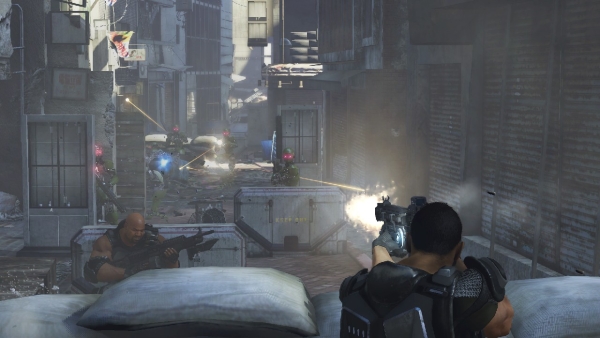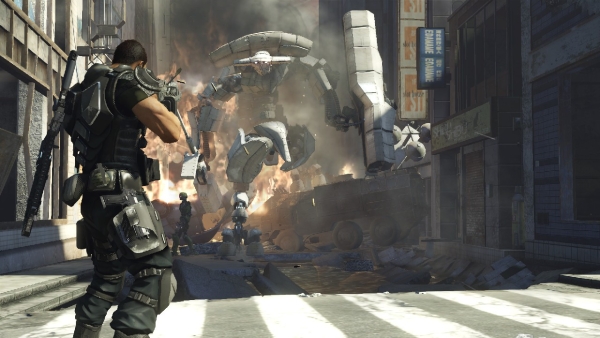
Even though game developers have tried dozens of times, there’s never really been a great video game adaptation of the Terminator franchise. While Sega’s Binary Domain isn’t an official tie-in of the James Cameron-directed movies, it may as well be. Producer Toshihiro Nagoshi and the rest of his Yakuza Studio have plucked plotpoints and design cues from The Terminator as well as Will Smith’s I, Robot and The Matrix. After mixing it all together, they’ve created something that doesn’t feel very original, but does feel like the Terminator game the world has always wanted.
Platforms: PS3, Xbox 360 (Version Played)
Publisher: Sega
Developer: Yakuza Studio
Genre: Terminator-Like Third Person Shooter
Release Date: February 28, 2012
ESRB Rating: Mature
In addition to a familiar story, the Gears of War series has made Binary Domain’s cover-fire mechanic feel very familiar to gamers over the years. Run-take cover-pop up-shoot-run-take cover-pop up-shoot. You know the drill.
Players control Sergeant Dan Marshall, an American soldier who’s part of an international mission to stop a group of rebellious robots. In the first stage of the demo, Dan is given the chance to select two additional members of his squad from a quartet of other soldiers. Each character brings different skills to the squad and will suggest different ways to complete a mission. Playing with gung-ho Big Bo is different than playing with the more tactical Charlie (though they both make sexist comments about any women on the team). Interestingly enough, if Dan selects a pair of women to accompany him, they’ll both start making sexist comments about him (selecting the two men, naturally, leads to a discussion about visiting a brothel).
The year is 2080, and war has broken out because governments of the world have outlawed human-looking robots, known as “Hollow Children.” But the discovery of some Hollow Children in Tokyo has prompted Dan and his team to search the city for the source of these skinjobs.

Each character in your squad is fully upgradeable thanks to the ATM-like Ammunition Transit terminals scattered around the stage. Using Credits earned in battle, Dan can upgrade his weapons and perform augmentations to his Skill Levels, such as faster healing or tougher armor, by purchasing nanomachine injections. All of these will be needed as the screen is very crowded with a ton of robots to shoot and a burnt-out city to explore. In fact, there’s so much to see, Binary Domain has a dedicated “Focus” button (pressing Y will make Dan look at a speaking character or something their gesturing at). Multiple status meters and other flashing distractions make the game feel even more chaotic, but multiple playthroughs make it all feel like second nature.
I was thoroughly impressed with the action sequences in Binary Domain. The squad-based, cover-fire mechanics may be old hat, but the game pulls them off well. The little touches make it work even better, such as including crawling robots who will push themselves along with their arms if you shoot off their legs (a la the end of Terminator 1) and seeing headshotted robots turn around and fire on their former comrades.
Another nice touch is the multipart boss fight against the “Grand Lancer.” Resembling a robotic xenomorph queen, the Grand Lancer has to be punched with a rocket launcher, then weakened with a steady stream of bullets, and then electrocuted by shooting a hanging wire. Finally, Dan has to climb onto the roof of a nearby building and jump onto the Grand Lancer’s head, shooting bullets into its robot brain to finish the fight.

The demo continues in a subway station, which is even more chaotic than the first stage. The second stage also introduces a new AI teammate, a French robot named Cain. A robot, fighting against other robots? Fascinating. That definitely piqued my interest in finding out where Binary Domain’s story leads.
The second stage offers more of the same action, but it also offers more opportunities to use the game’s Voice Command system. Plugging a microphone into your controller enables Dan to give orders to his squad via voice command. As long as the commands are “fire” or “yes/no,” the system works great. But if you tell your squad something complicated like “cover me,” they’ll fire back with “I don’t understand.” While the Voice Command system is an interesting gimmick, I can’t picture myself using it through the whole game. Dan’s teammates are already pretty self-sufficient on their own. They don’t need much direction, so it was easy to ignore the Voice Command system most of the time.
Binary Domain will be available in stores next week and it’s shaping up to be an action-packed entry in the squad-based shooter canon. Sure, the story is a rehash of The Terminator (with a detour through Blade Runner), but the world needs a break from traditional shooter fodder like Nazis, zombies, or Nazi zombies. Maybe robots can fit the bill.







